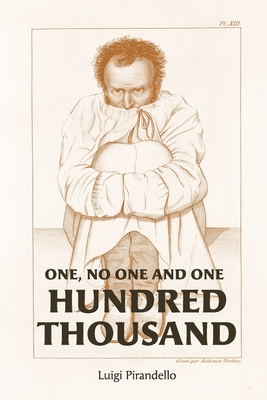One, No One, and One Hundred Thousand

One, No One, and One Hundred Thousand
After all, the "Moscarda" he believed himself to be was different when he was alone, or with his wife, his tenant, or his friends. And there were hundreds--no, thousands--of additional Moscardas in the minds of everyone who had met or heard of him.Moscarda grappled with this new knowledge: that he was not who he thought he was, nor who anyone else thought he was. And the people around him? They were not who he thought they were either.So he decided, in his own words, to "...find out who I was, at least to those closest to me, acquaintances so-called, and to amuse myself by maliciously decomposing the I that I was to them." What follows is a series of experiments, meant to befuddle and confuse those around him and prove that he was not, in fact, who they believed him to be.Written by Nobel Laureate Luigi Pirandello over the course of 15 years, One, None, and One Hundred Thousand was a groundbreaking look at the nature of identity and the self.Pirandello was no stranger to reinvention and loss of identity. Born into a well-to-do Sicilian family, he seemed destined to follow his father into business as a sulfur merchant. Instead, he spent his youth writing stories, and later excelled in literary studies.Pirandello's early writing and teaching at the Istituto Superiore di Magistero di Roma was sufficient to support himself, his wife, and his three children--supplemented by an allowance from his father and his wife's dowry.But in 1903, the family was ruined when the sulfur mines his father had invested in were flooded and destroyed. The family fortune was gone, including his wife's dowry. The news so shocked her that she suffered a complete mental collapse. In the aftermath, she suffered from hallucinations and anxieties that would follow her for the rest of her life.At first, with an ailing wife and no money, Pirandello contemplated suicide. Instead, he redoubled his efforts. He took on more teaching work and wrote at a furious pace. He would go on to write 7 novels, numerous short stories, poetry, and around 40 plays throughout his career.The issue of identity comes up again and again in Pirandello's work. In his play To Clothe the Naked, the protagonist tries to reinvent herself, with each subsequent identity stripped away from her by others. In The Life I Gave You, a mother is confronted with the truth that her long-lost son is not the person that she has created in her mind. In the end, she chooses to adhere to her fiction rather than face the fa
PRP: 149.90 Lei
Acesta este Prețul Recomandat de Producător. Prețul de vânzare al produsului este afișat mai jos.
134.91Lei
134.91Lei
149.90 LeiLivrare in 2-4 saptamani
Descrierea produsului
After all, the "Moscarda" he believed himself to be was different when he was alone, or with his wife, his tenant, or his friends. And there were hundreds--no, thousands--of additional Moscardas in the minds of everyone who had met or heard of him.Moscarda grappled with this new knowledge: that he was not who he thought he was, nor who anyone else thought he was. And the people around him? They were not who he thought they were either.So he decided, in his own words, to "...find out who I was, at least to those closest to me, acquaintances so-called, and to amuse myself by maliciously decomposing the I that I was to them." What follows is a series of experiments, meant to befuddle and confuse those around him and prove that he was not, in fact, who they believed him to be.Written by Nobel Laureate Luigi Pirandello over the course of 15 years, One, None, and One Hundred Thousand was a groundbreaking look at the nature of identity and the self.Pirandello was no stranger to reinvention and loss of identity. Born into a well-to-do Sicilian family, he seemed destined to follow his father into business as a sulfur merchant. Instead, he spent his youth writing stories, and later excelled in literary studies.Pirandello's early writing and teaching at the Istituto Superiore di Magistero di Roma was sufficient to support himself, his wife, and his three children--supplemented by an allowance from his father and his wife's dowry.But in 1903, the family was ruined when the sulfur mines his father had invested in were flooded and destroyed. The family fortune was gone, including his wife's dowry. The news so shocked her that she suffered a complete mental collapse. In the aftermath, she suffered from hallucinations and anxieties that would follow her for the rest of her life.At first, with an ailing wife and no money, Pirandello contemplated suicide. Instead, he redoubled his efforts. He took on more teaching work and wrote at a furious pace. He would go on to write 7 novels, numerous short stories, poetry, and around 40 plays throughout his career.The issue of identity comes up again and again in Pirandello's work. In his play To Clothe the Naked, the protagonist tries to reinvent herself, with each subsequent identity stripped away from her by others. In The Life I Gave You, a mother is confronted with the truth that her long-lost son is not the person that she has created in her mind. In the end, she chooses to adhere to her fiction rather than face the fa
Detaliile produsului











